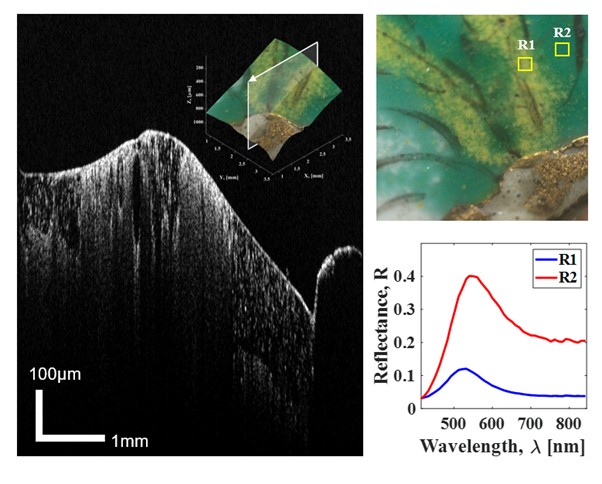Service: Hybrid OCT @ 1350nm & Microscopic VIS/NIR Spectral Imaging (415-845 nm)
Platforms
Fixlab
Molab
Techniques
Optical coherence tomography (oct)
VIS/NIR reflectance spectral imaging

Organization
United Kingdom
Service contact persons
Reference
The Hybrid system combines optical coherence tomography (OCT) system with a reflectance spectral imaging system into one instrument. OCT provides 2D and 3D virtual cross-sectional images in a non-invasive and non-contact way. It is suitable for the investigation of translucent and transparent materials (e.g. varnishes, glass, glazes) in the near-infrared (central wavelength 1350 nm). VIS-NIR Spectral Imaging can provide identification of materials. The simultaneous use of the two analysis methods allows for a 1:1 spatial alignment between the spectral images and OCT 3D volumetric data sets, providing additional context on the layer structure.
OCT is a fast, non invasive and efficient technique for the collection of 2D and/or 3D measurements of an object's surface and subsurface structures, at a resolution on the order of a few microns. The technique requires objects to be at least semi-transparent to near infrared radiation, making it well suited to investigating materials like varnishes, paint glazes, some paint layers, glazes on ceramics and faience, jade, historic glass and enamels, amber, rock art, parchment and paper. The 2D cross sectional images obtained by OCT are usually presented in the convenient manner of cross-sectional views, similar to microscopic images of sample cross-sections extracted from the object. If necessary, 3D information of an entire volume (a cube) may be collected by combining a sequence of up to 1000 cross-sections across the surface.
The major advantages of OCT are the ability to see the layers and microstructure below the object surface in a non-contact and non-invasive manner (intensity of light used for examination is in the order of a few milliwatts), and the rapid speed of data collection with no need for object preparation. The speed of data collection and online imaging makes the technique also ideal for monitoring dynamic processes in which the stratigraphy is likely to alter, for example during conservation treatment. Given the non-invasive nature of the technique, the number of measurements across the entire surface can be unlimited, making it possible to have a representative view of the whole object.
The Hybrid instrument is also equipped with a filter based spectral imaging system. Visible- Near infrared Spectral Imaging is an efficient method of collecting reflectance spectra over an area at a microscopic resolution, allowing spectral mapping over a region and enabling the identification of most pigments commonly used in historical artworks. The coalignment of the two modalities allows for a 1:1 spatial alignment between the extracted spectral images and OCT 3D volumetric data sets, providing additional context on the layer structure. In specific cases, the relationship between spectral imaging and layer thickness extracted from OCT can provide depth resolved identification of a layer. An ideal tool for online monitoring of varnish cleaning.
For accurate collection of reflectance spectral imaging, dark environments (either a dark room or enclosure) are ideal.
Fields of application
Archaeology
Conservation (discipline)
Conservation science (cultural heritage discipline)
Heritage science (cultural heritage discipline)
Materials
Ceramic glaze
Glass
metallurgical by-products
stone
Pigments
adhesives and glues
Varnish
wood
Paper
paint glaze
Methods
Other information
-
Input: High Resolution Colour images of the regions for marking the location of OCT data collection
-
Output: OCT cross-sections in adjacent, parallel locations ( file format negotiable) layer thickness surface profile maps and/ or OCT Intensity Projections of the OCT region if requested ( file format negotiable) colour images, e.g. RGB, CIE L*a*b* (file format negotiable) spectral image cubes (file format negotiable) ASCII meta data file All data are linked through the MAPSI app with measured areas marked and any comments on the data

